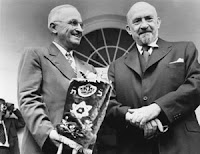On Monday morning, September 28, 1964, the day after my parents dropped me off at the University of Cincinnati for freshman orientation, my mother IM'ed me:
That was the first of more than 30 years of little “Tweets”
from the nest, frequently on 4¢ postcards. “Dad
got you some Picasso posters for your wall.
Will keep them here ‘til you come home. Sears came yesterday to
look at the refrig door and needs a new handle.”
Financial matters were a frequent topic. “If your books cost
more than you think, let us know.” “Your state tax refund check of $21.55 came,
so I took the liberty of depositing it in your saving account.” “Your bank statement arrived but will hold it
till you come home.” “Dad says you are due a 48¢ tax refund but I’ll combine it
with whatever else we owe you.” “Rather
than send you the coins, I enclose some stamps.” “Please don’t hesitate to call collect
because we don’t want to miss hearing from you just because you’re low.” “Take this $2 for your shampoo.” “Please
inform Dad well in advance when your next Quarter payment is due.”
She was my agent on my recurring search for a summer
job. “Mrs. P. will mail the application
to me and I’ll send it right away.” “Ida
Lee is quitting Richard’s for the summer.
Shall I inquire for you? $1.25
per hour.” “Just wanted to let you know Alma
called and gave me the name of the woman in her personnel office for you to
call.”
My mother, like many women of her generation, did not work
regularly outside our home once she was married. When my brother and I went to college, she
worked part-time. While I was much more
of a feminist than most of my friends, I did not question my mother’s way of
life. I thought of it as her “choice,”
and I am still mostly convinced that it was the choice my father preferred too. She had one year at Northwestern, but dropped
out because of the Depression.
When my father returned from the Pacific, they married and
dad began a nearly 30-year career as a lawyer with the Veterans Administration,
work that filled him with great pride as he helped his fellow soldiers find
their way through the GI Bill for education and medical benefits.
Her source of pride was being encouraging and helpful to everyone. She was the willing receiver of all kinds of communication,
and the smiling and contented fountain of comfort and tenderness. She took a sincere interest in everyone’s
achievements. She was as attentive to my
brother’s needs as she had been to mine when I was still home. Pick up kids? Call Neal’s mom! Even
after we
both were no longer living at home, she was the one they all depended
upon. She looked after her mother, her younger sister, and my father's
father,
bringing them frequently to our house from Chicago for days at a time.
She tweeted it all.
She never told people what to do, but her wisdom
was accepted and appreciated widely. She got at least one or two calls a
week from my high school
friends, now away at college too, eager to speak to the mother who
always had
time to listen. “Sorry to hear M.’s using such poor judgment but like I
said, people will do what they want and live as they like, whether or not you
worry about them.” “S. brought the baby by
after her 3-month check-up. Baby’s fine, but S. needs a kidney test.” She baked batches and batches of cookies that
she sent to my friends and cousins.
She was always occupied, not watching television or drinking coffee with friends. "Had a busy time at the penny end of the candy
counter yesterday.” “This coming Monday is sisterhood opening dinner [turkey,
$1.99], so I’m going, to collect the money.
Mrs. S. said we wouldn’t have to give any reports.”
“F and R are coming Thurs. and hope they will stay for
dinner this time. I will make a
chocolate malted cake and freeze a piece for you.”
“Saw S.C. at airport and he asked about you . . . He’s still
going to school and feels the hot breath of the draft.”
She did occasionally have lunch with friends.
She weeded. She grew tomatoes and
gave them away. She didn’t like
housework and moaned about dustballs, but whenever I went home, they were
still there. “Don’t let it get around
that your mother scrubs a floor without a mop, or your marital prospects will
be nil.”
I wrote back, not so frequently, also postcards: “This Saturday is Homecoming. Guess I’ll go to the Library so I don’t hear
the sounds of the game. The concert last
night was great, especially Belafonte’s now famous rendition of ‘Hava Nagila.’”
She was our Internet Service Provider, the center of a vast network, our Google. She was, I realize,
the reason that staying in touch with my friends and being a connector came to
mean so much to me. I saved most of her
letters and postcards, and she saved mine.
Who knows why? My historian
friends have convinced me that these three decades of Tweets offer a rare
written record of a few moments in 20th century history, so I will be donating them to the American Jewish Archives in Cincinnati. They are a precious source of reflection and life review to me, but they also provide a glimpse of everyday lives.















